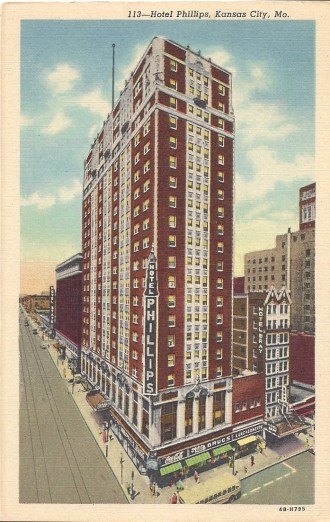Welcome to the Fabulous 1930s
The Walnut Room, Marcus Hotels, Baltimore 12 restaurant, live music, historic hotel

Compared to the smooth glass and modern gray concrete of the U.S. Bank Tower[1] building on 12th Street, its neighbor, the Hotel Phillips, takes you back in time in a matter of steps with its warm brick stonework. The true magic, and storytelling, however, happens when you step inside its revolving doors.
Built in 1931, Hotel Phillips offers exquisite examples of art deco[2], which had just hit the vogue scene. (Now, the hotel is listed in the National Register of Historic places as one of the best examples of art deco in Kansas City.) A grand reception desk with rich, walnut walls, hand-carved pillars, warm tones of gold and red, and muted lighting greet you. Back in its heyday, and even now, the hotel was known to have a European elegance. At its open, the elevators, which moved at the speed of 600 feet per minute, boasted expensive herringbone floors and extensive walnut woodwork.
Between two grand staircases that lead to the mezzanine, Dawn, the winged goddess of stars, stands high above visitors holding a torch. Charles E. Phillips, the hotel and apartment builder responsible for developing the Hotel Phillips, wanted to provide guests with a symbol of warmth and hospitality. He had the city’s leading sculptor, Jorgen C. Dreyer, create Dawn, who depicted Dreyer’s ‘ideal woman[3].’ The gold painted, bare-breasted statute soon became a well-known symbol for the hotel.
Going down a flight, you reach the Walnut Room that is, you guessed it, covered from floor to ceiling in beautiful, hand-carved walnut. It is said that the room was perfect for an Al Capone speakeasy-type get-together because of its dark, windowless quarters during the prohibition years. On the record, about a decade later during World War II, the room housed busy officers clubs for dinner.
The hotel was built for $1.6 million dollars, which is more than $22 million today. At the time, it was the tallest hotel in the area with 20 floors. Kansas City’s Maxine Tappan, who later became a famous actress and opera singer, performed during the hotel’s grand opening party on February 23, 1931. Tappan wasn’t the only celebrity to grace the hotel and area.
In the 1920s, before Phillips hatched the idea of Hotel Phillips, the corner of 12th and Baltimore was soon to be written in the history books. The Glennon Hotel originally sat on this corner and became the home of Harry S. Truman’s (who eventually become the United States’ 33rd President, in case you didn’t know) Haberdashery, a clothing store, in the 1919. Truman rented an 18 by 48 storefront in the hotel for $350 a month, which is almost $5,000 today. However, Truman’s store didn’t last long and he eventually lost the business. Luckily, that didn’t stop him from pursuing a more important career in life. Dwight D. Eisenhower[4] also stayed at the hotel along with movie stars such as Wallace Beery[5].
The hotel prospered for many years to come until a fire broke out in 1952 that caused almost $300,000 in damages on the second floor. But, the hotel bounced back. Along with much of the city in the 1970s, the Hotel Phillips closed its doors in 1971 because of financial hardship. The hotel’s ownership bounced from owner to owner throughout the 1970s. Even Rockhurst University[6] tried its hand at owning the hotel in the 1970s. At one point, only 35 percent of the hotel would be occupied at any given time. For the next 30 years, more than $40 million was spent on renovations from the hotel’s various owners. The Hotel Phillips reopened its doors once again on September 13, 2001 under the ownership of Marcus Hotels. It has been thriving ever since.
Now, whether you’re visiting the hotel’s restaurant Baltimore 12 for a night of local jazz while endulging in chef Justin Voldan’s unique, Boulevard Brewery-inspired menu,[7]or just stopping by to marvel at its art-deco style art, Hotel Phillips is a grand place to escape to the past.










